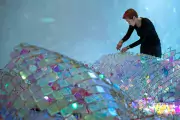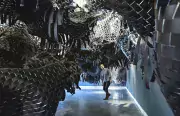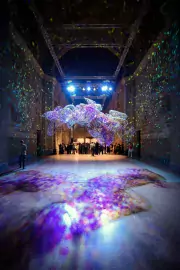
Alum explores space with unconventional materials

Sheetrock, fencing, plastic, and glass—materials most associated with construction work, road signs, and other utilitarian uses—take on new forms and a new importance in the hands of Columbus College of Art & Design graduate Soo Sunny Park (Fine Arts, 1998). Park uses these types of boundary materials to consider light and expand and explore liminal spaces, the in-between of such concepts as inside/outside, sculpture/drawing, and vision/perception.
After graduating from CCAD, Park earned her MFA in 2000 from Cranbrook Academy of Art in Bloomfield Hills, Michigan, and then a residency at the Skowhegan School of Painting and Sculpture in Maine. Park and her work have been honored and exhibited around the globe, with residencies and awards including Grand Prize at the 19th Annual Michigan Fine Arts Competition; Helen Foster Barnett Prize: The National Academy Museum, New York; Cite Internationale des Arts Studio Residency, Paris, France; The Rockefeller Foundation: The Bellagio Center Fellowship, Bellagio, Italy; Kultur Osterbotten Fellowship, Ateljé Stundars Residency, Korsholm, Finland; Vancouver Biennale Artist-in-Residence, British Columbia, Canada; and The Cheekwood Martin Shallenberger Artist-in-Residence, Nashville.
Park now is a Professor of Studio Art at Dartmouth College in New Hampshire, a position she holds in addition to her full-time artistic practice, and for which she was honored by CCAD in 2019 with an Arts Educator Alumni Award. One of her most recent projects, Viewing Filter (Veil of Vision), was delayed by the COVID-19 pandemic. Originally scheduled to go on view at the San Jose Institute of Contemporary Art in California in November 2020, the ICA show instead opens March 25, 2022, and is on view through August 14, 2022. In addition, Park was selected to be part of the Smithsonian Institution's 175th anniversary show FUTURES, on view through July 6, 2022.
Chain-link fencing, plexiglas, projectors, and sheetrock are some of the materials you typically work with in the creation of your sculptures. Have you always worked primarily with these materials? What is their appeal compared to more conventional media?
No, not always. At CCAD, and then at Cranbrook, my thoughts about sculpture were shaped by Boris Groys’ writing on collection and preservation of artwork. He suggested that the art-making system compelled the artist to create “new” work in order to be collected. My early efforts (1997–2004) were thus ephemera that created lasting experiences via impermanent events, while the form was eventually reclaimed by nature or reprocessed into another sculpture or substance. For example, Painted Space (1999) was clothing made of paint and glue. By wearing the paint-clothing, the viewer became the canvas, but in this case he or she could look out at the world, literally seeing from the point of view of an artwork rather than looking at the artwork from some distance. The more the viewer’s body moved in space, the more the paint-sculpture fell apart, leaving art as an experience rather than an object.
Since about 2005, I have been using more permanent materials like acrylic, sheetrock, and fencing to explore liminal spaces. I also started thinking a lot about light. I moved to rural Vermont in 2005 and when you’re out in the country, light is just more important. The sun sets and there often aren’t any streetlights, so it gets very dark. Driving in the dark makes you notice how road signs reflect light very intensely. This inspired a series of drawings and photos using retro-reflective glass beads, which is the stuff in the road signs, and pavement markings. I was also inspired by the snowy hills of Vermont to shape forms out of fences. In SSVT—Vapor Slide I used translucent plastic cups embedded in welded fencing, strings, and rocks to explore the space between the snow and the rocks below. In a way, it pulled apart the snowy top of a hill from its rocky surface below.
I noticed, too, that my pieces transform spaces differently depending on the light, natural or artificial, and this got me focused on light. We don’t really notice light, but everything we see we see because of light. It’s between us and what we see, so it’s a liminal kind of thing. So I started thinking that the work should push this idea of light as a material in my installations, just as physical as the fencing and glass. I didn’t want to do what people like James Turrell were doing. He focuses us on light by drawing us away from the concrete materials in his work. I want light to be more like concrete, or fencing and glass, and less ephemeral and ethereal than it’s usually taken to be. It plays its own material part in the installation, alongside these other things.

How did your time as a CCAD student influence the work you do today?
I started my career at CCAD as a painter, and I still feel pretty confident with my painting skills. It was there, too, that I really started to see that I wanted to do sculpture and CCAD gave me the room to develop in that way.
I also appreciate how well grounded I feel having gone through a traditional Bauhaus-influenced program with foundational courses in 2D and 3D design, structure drawing, color concepts, anatomy, and even typography. The skills I learned back then have been a constant help both in my work and in my teaching.
Did any CCAD professors or fellow students influence your work, either directly or indirectly?
I have many fond memories taking courses with amazing professors at CCAD. In 3D, I learned from Professors David Burghy, Peter Rasmusen, and Charlie Brown. For oil painting, Professors Gordon Lee, Dennis Drummond, and Nathaniel Larrabee (who was a very tough grader—getting a C from Larrabee was something that students celebrated). I took at least three watercolor courses with Professor Carol Griffith because I loved the focus and peacefulness she brings to her class. One of the most challenging classes was Typography with Professor Richard Aschenbrand. I enjoyed how demanding his assignments were, so I ended up taking another Typography course with him, which opened my eyes to abstraction and composition in a new way.
I took a number of drawing and mixed media courses at CCAD. I took four or five courses with Professor Anita Dawson. She was very open to students’ material experimentation, and very insightful, gave great constructive feedback on how to further develop experiments. There was also (now-Provost) Julie Taggart, who taught an amazing anatomy drawing class during my freshman year. And at the time it was her first year in teaching, right out of graduate school. She was a great mentor throughout my time at CCAD and subsequently, I thought of her a lot as I started to teach right after my graduate study.
There were many great artist-teachers at CCAD. Seeing a CCAD faculty show was a very exciting and inspiring event. During my first year, I saw (now Faculty Director of Galleries) Tim Rietenbach’s work in the show, and was blown away by its ingenuity and wit. I still vividly recall this one piece by him, a gigantic circle wall piece that hung very high. It looked as though it was on fire in the way he carefully assembled the disparate materials and artificial lights around its frame. The next academic year, I sought out to take a 2D/3D design course with him. Even though he only taught the foundation courses during the time I was at CCAD, he was a great teacher and mentor who helped shape me as a sculptor. He was one of my critics at the senior thesis defense, and he and another professor got into a very heated debate about an art concept in the middle of my critique. I appreciate his out-of-the-box views and push for individuals’ voices.

You work as both an artist and an educator. What advice would you give to a young artist who wants to make a career in contemporary art?
Teaching is very rewarding on its own, and it gives you time to be creative with your work. So, I have been teaching since I got out of grad school in 2001. Teaching sculpture and drawing helps make you a better artist, but it also helps because teaching can give you time to explore your own ideas. I have met lots of professional artists over the years, and each one has found their own way into making a career. So, I don’t think there is anything like a recipe. But because of that I think it helps to talk to other artists who are farther along just to see how they made things work for them.
Don’t be afraid to ask for advice. Don’t feel like there is just one model for succeeding, or one standard for success. It is crucial to follow your instinct and work hard steadily with discipline. I think having a career in art is about surviving through your own doubts, having conviction and accountability to your own work, and realizing that your work is a part of a larger dialogue and does not operate alone.
I didn’t take the route of working with any galleries, but I was able to have museum shows and get commission projects. Sometimes, though, having a good gallerist can make all the difference to your career. Also remember that when you wind up selling work you are, partly, in business. And business is complicated. Once you are signing contracts, consider getting professional advice on how to do things from a lawyer. Anyone asking you to sign a contract had a lawyer write it, so you shouldn’t hesitate to try and get a lawyer to read it before you sign it.
How important is scale in the work you do?
My work aims to transform spaces in unexpected ways. So, the goal is always transformation of a space, and often I just think of the work as occupying the whole of that space. Yes, the fencing and glass takes up some space, but the work, including what it does with light, fills the whole. In terms of the parts I make in the studio, I make them so that they can do the job of transforming the space. In that way, scale is relevant to me, but not in the same way it might be for someone who makes objects. When I make objects, I want them to be the size of things individual people can interact with, so in that sense they are often roughly human-sized.
What do you want people to experience when they encounter your work?
I want people to notice the physical world, and experience it coming together with an imagined one. Hopefully, this makes people stop and think about how we have divided our world and the ways in which we might do that differently. Different people will also have their own thoughts about the work, so I offer it in the spirit of exploration.
Your artwork has influenced fashion designers, most notably Josep Font. Is your work influenced by fashion design or specific fashion trends or designers? If so, how?
I love fashion, architecture, and industrial design. I think all of those practices, in different ways, are arts of space. What we wear affects how we can move through and interact with the rest of the world. The design of the spaces we inhabit and the things we use in them shapes our world just like the concepts we have for thinking about things. So, when I make work to transform space, it is always in conversation with other arts.

You moved to this country from South Korea at age 10. How, if at all, does that experience, both as an immigrant and as a Korean American impact your work?
My parents left Korea for the US when I was eight, but I could not follow them for another three years. I had to stay in Korea with extended family, and while there I almost drowned, and while that was happening I felt separate from the world and my own body. This made me ask: What is this space outside of the mind and the body?
When I got to the US, I was reunified with my parents and sisters, but it was difficult because I was now in a world where people spoke a foreign language. Art, for me, has always been about this betweenness. Familiar and unfamiliar, comprehensible and obscure. This, I think, is what led me to think of liminality as an important theme in my work. Boundary materials exist between and create spaces: walls, windows, fences, etc. My work treats those materials not as dividers, but space creators. A welded fence stretches to fill a space and transform it, and so it’s not breaking up spaces but creating new ones.
What’s up next for you?
I am very excited to be in a show celebrating the reopening of the Smithsonian’s Arts + Industries Building on the National Mall in Washington, DC this November. The Smithsonian combines my interests in art, design, and science. Also, just as the COVID-19 pandemic hit, I was about to install a piece at the San Jose Institute of Contemporary Art. The show was delayed but it is scheduled to open in early 2022. This is the first piece of mine that makes heavy use of retroreflective paint, and viewers will explore the piece using flashlights in a darkened room. I am really looking forward to hearing how people feel about it.
Soo Sunny Park: Viewing Filter (Veil of Vision) is on view at ICA March 25–Aug. 14, 2022, and includes a free, public walkthrough tour and discussion with Soo Sunny Park on March 25, 2022.
Read more about Soo Sunny Park on her website or on Facebook. Read Artnet's coverage of the Smithsonian show right here.
Learn more about CCAD’s Fine Arts major or apply here.
Post date
May 21, 2021